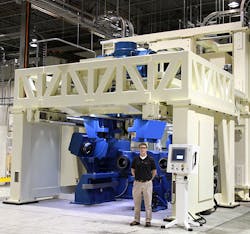The Department of Defense (DoD) had a problem: how to reduce spending on helicopter transmission and gearbox testing while also streamlining the testing process and increasing the accuracy of test results. The answer is a set of flexible test systems with a unified, user-friendly interface.
Universal helicopter test stands have been few and far between because of the complex and varied geometries of helicopter transmissions and gearboxes, diverse dynamic operation and varying load requirements. Existing test software and controls were developed around individual original equipment manufacturer (OEM) requirements, types of testing, and test system manufacturer preferences. The result has been unique test systems for each test article and each helicopter OEM.
With more than 20 aging, dedicated test stands, each designed to accommodate a unique helicopter transmission or gearbox, testing was complex and time consuming. Worker environments were less than optimal, the testing process took days, spare parts were sparse and expensive, and most of the energy used during testing was converted to wasted heat.
There were three parts to the project – a completely new testing process, new flexible powertrain test stands, and new universal testing software.
In the existing environment, the test article is assembled, dressed, tested and torn down, all while inside the test stand. This led to days of test system inactivity. A redesigned process moved all test prep and breakdown outside of the test cell. Custom transportable test fixtures were designed with quick connects and automated clamping so that a fully prepped test component could be quickly mechanically aligned, loaded, and electrically connected to the stand. Machine mounted radio-frequency identification (RFID) readers use fixture-mounted tags to identify the component type prior to test and automatically configure the machine and load its test profile.
Instead of taking hours to build up and break down the test article inside the stand, the new process requires approximately 15 minutes for each. Depending on the duration of the test, throughput is increased by up to 400 percent.
The new test stands are designed with modular gearboxes, allowing each test stand to accommodate multiple powertrain components. The size of a two-story building, a single main transmission test system can handle seven or more different helicopter transmissions as well as countless future variants. Separate flexible test stands were engineered to handle tail and intermediate gearboxes as well as other critical dynamic components. Test stand gearboxes are designed to be swapped out and change position to test different components.
To reduce energy consumption, electrical regeneration was integrated to provide load control and load absorption, allowing up to 80 percent of the power required during testing to be recaptured, either to power the test stand itself or be returned to the grid.
The main transmission flexible test system, while running at full capacity, will cost approximately $400 less per hour to operate than the former DoD systems. This could easily translate into savings of approximately $500,000 per year on a single test stand.
Finally, a machine software and control package was designed to perform all the required dynamic tests and allow an operator trained on one test system to be competent on any of the others. A modular software system and HMI platform was designed for all five test stands, with a common user interface and plug-in architecture, common function blocks, I/O coding and CAT 4 safety functions. The test profiles, formerly hard coded into each stand, are now generated and stored independently from the hardware. Test profiles are identified to the test article via RFID and the resulting test data is captured and stored to create a traceable test history for each transmission and gearbox.
Chris Lake, [email protected], is vice-president of engineering at RedViking Engineering, a member of the Control System Integrators Association. Chris will also be presenting at The Automation Conference in May 2014 – plan to attend to learn more about this project and meet with Chris in person.
About the Author
Chris Lake
Vice President of Engineering at RedViking Engineering

Leaders relevant to this article:
